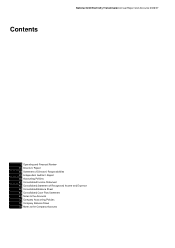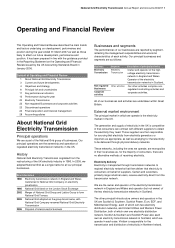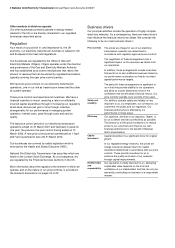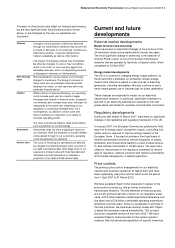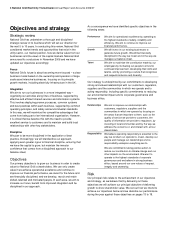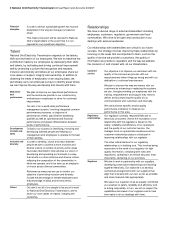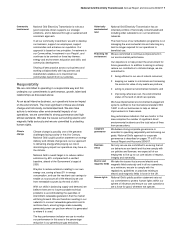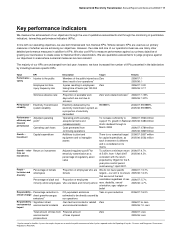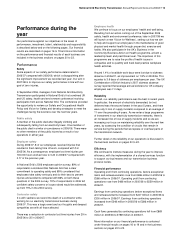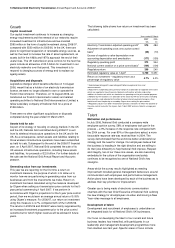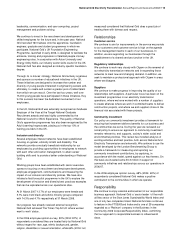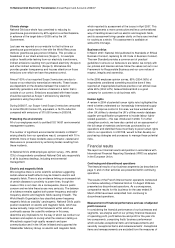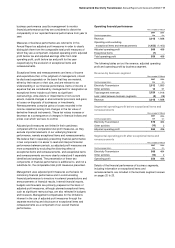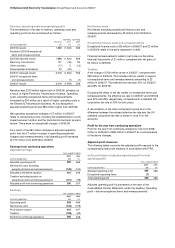National Grid 2007 Annual Report Download - page 10
Download and view the complete annual report
Please find page 10 of the 2007 National Grid annual report below. You can navigate through the pages in the report by either clicking on the pages listed below, or by using the keyword search tool below to find specific information within the annual report.
8 National Grid Electricity Transmission Annual Report and Accounts 2006/07
Principal risks and
uncertainties
Risk management
Understanding and managing risks is integral to the way we run
our business. We have a well established enterprise-wide risk
management process that ensures risks are consistently
assessed, recorded and reported in a visible, structured and
continuous manner, the outputs of which are primarily used as
a management tool. A secondary and natural output from this
process is information that provides assurance to management
at all levels and thus helps safeguard our assets and reputation.
It is designed to manage rather than eliminate material risks to
the achievement of our strategic and business objectives while
also recognising that any such process can provide only
reasonable, and not absolute, assurance against material
misstatement or loss. This process complies with the Turnbull
working party guidance (revised October 2005) and, in addition,
contributes toward our compliance with our obligations under
the Sarbanes-Oxley Act as well as other internal assurance
activities.
Risk management in National Grid Electricity Transmission has
become further embedded over time and our experience of this
has enabled us to identify a number of key success criteria
linked to both the risk management framework and process
that, if in place, will help ensure the process continues to
remain embedded.
The risk management process continues to be based on both
bottom-up and top-down assessments of operational, financial
and other business or project risks. From the bottom-up, our
business units prepare and maintain risk registers that capture
their key risks and the actions being taken to manage them.
These risk registers are regularly reviewed and discussed by
the executive committees for those business units. The key
element in the top-down assessments of the enterprise-wide
risk profile is the involvement of Directors and other senior
management at critical stages in the review process. Their
review and debate of bottom-up assessments produces the
overall evaluations of the risks that are faced by National Grid
Electricity Transmission. In addition, the Executive, the Risk &
Responsibility and the Audit Committees of National Grid plc
review National Grid’s overall risk profile twice a year. The Audit
Committee of National Grid plc also reviews the risk
management process at least once during each year and
reports on this to the Board of National Grid plc.
During the year we have continued to derive benefits from this
process through ongoing interaction with National Grid plc’s
Internal Audit function and Sarbanes-Oxley teams. The external
benchmarking exercise of National Grid as a whole has
continued with other FTSE 100 companies and public sector
organisations to measure the effectiveness of our own
approach and exchange ideas on best practice. With the move
to a line of business operating model, the opportunity is being
taken to restructure risk and compliance management services
to ensure approaches are consistent across businesses and
continue to provide value to business operations, including
major projects.
Risk factors
Our risk management process has identified the following risk
factors which could have a material adverse effect on our
business, financial condition, results of operations and
reputation, as well as the value and liquidity of our securities.
Not all of these factors are within our control. In addition, other
factors besides those listed below may have an adverse effect
on National Grid Electricity Transmission. Any investment
decision regarding our securities and any forward-looking
statements made by us should be considered in the light of
these risk factors.
Change in law or regulation could have an adverse effect
on our results of operations.
Our principal businesses are utilities or networks that are
subject to regulation by the Government and other authorities.
Consequently, changes in law or regulation could adversely
affect us. Regulatory decisions concerning, for example,
whether licences or approvals to operate are granted or are
renewed, whether market developments have been
satisfactorily implemented and whether there has been any
breach of the terms of a licence or approval, the level of
permitted revenues for our businesses and proposed business
development activities could have an adverse impact on our
results of operations, cash flows, the financial condition of our
businesses and the ability to develop those businesses in the
future. For further information, see the ‘External market
environment’ and ‘Regulation’ sections of this Operating and
Financial Review.
Breaches of, or changes in, environmental or health and
safety laws or regulations could expose us to claims for
financial compensation and adverse regulatory
consequences, as well as damaging our reputation.
Aspects of our activities are potentially dangerous, such as the
operation and maintenance of electricity lines. Electricity utilities
also typically use and generate in their operations hazardous
and potentially hazardous products and by-products. In
addition, there may be other aspects of our operations which
are not currently regarded or proved to have adverse effects but
could become so; for example the effects of electric and
magnetic fields. We are subject to laws and regulations relating
to pollution, the protection of the environment, and how we use
and dispose of hazardous substances and waste materials. We
are also subject to laws and regulations governing health and
safety matters protecting the public and our employees. Any
breach of these obligations, or even incidents that do not
amount to a breach, could adversely affect our results of
operations and our reputation. For further information about
environmental and health and safety matters relating to our
businesses, see the ‘Our Responsibility’ section of National
Grid’s website at www.nationalgrid.com.


